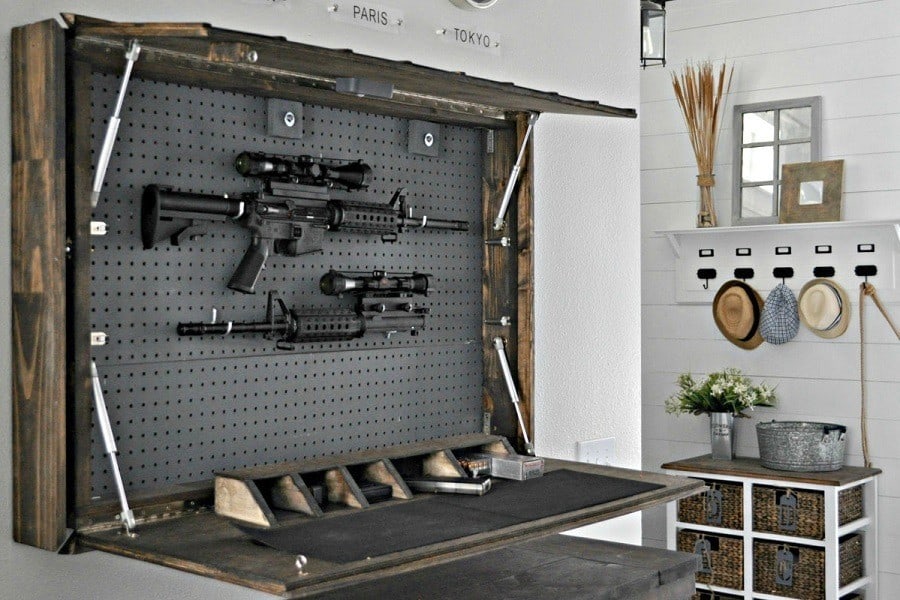
Alright, so you're thinking about building a DIY in-wall gun cabinet, huh? That's a great way to keep your firearms secure and hidden, while also adding a bit of custom style to your home. It might seem intimidating at first, but trust me, with a bit of planning and some basic carpentry skills, you can build a solid, safe storage solution.
First things first, safety:
Let's talk safety. This is serious business. We're dealing with firearms here, so we need to make sure your DIY cabinet is up to the task. Here's what you need to consider:
Local Laws and Regulations: The first step is to check your local laws and regulations about gun storage. Every area has different rules, and you want to make sure you're in compliance.
Security: You need to choose sturdy materials and strong locking mechanisms that can withstand a forced entry. Think about how you'd want to secure your cabinet if you had to. Would you prefer a lock with a key, a combination lock, or a biometric system?
Accessibility: You want to ensure your cabinet is easily accessible to you, but not to someone else. A well-placed, hidden cabinet might be the right choice.
Planning your In-Wall Gun Cabinet:
Now, let's get down to the nitty-gritty of planning. Here's a step-by-step breakdown:
1. Choose your Location: Where will your cabinet be? You'll need to consider the wall's structure and what's behind it. You don't want to hit any pipes or electrical wiring. A stud wall is ideal, but you can also consider other options like brick walls or concrete. Think about how you'll access the cabinet: Is there a convenient way to open it, or will you need to move furniture?
2. Design and Measurements: You need to decide what size you want your cabinet to be. Consider how many guns you need to store, the size of the firearms, and how you want to organize them. Draw up a basic plan on paper. You'll need to measure the area where your cabinet will be placed very carefully.
3. Material Selection: For the frame of your cabinet, you'll need something sturdy. 2x4s or 2x6s are excellent choices for the frame. For the doors, you can use plywood or even heavy-duty sheet metal. You'll also need some hardware like hinges, a lock, and possibly a door handle. Don't forget about the interior: you can use shelves, racks, or dividers to organize your firearms.
4. Building the Frame: Start by cutting the wood for the frame to your measurements. Make sure all your cuts are accurate. Use wood glue and screws to join the pieces of wood together. You can add extra support by using bracing or corner blocks.
5. Framing and Electrical Considerations: If you’re cutting into a wall, you will need to consider your electrical wiring. If you have a finished wall, you’ll need to cut out sections of the wall for the framing. This can be done using a reciprocating saw, or even a drill and a hammer. Be extra careful if you are near electrical wiring or pipes. You can use a stud finder to ensure that you avoid hitting any pipes or wires.
6. Installing the Cabinet: Once your frame is built, you’ll need to secure it to the wall. Use heavy-duty screws or bolts to attach the frame to the studs. Make sure the cabinet is flush with the wall.
7. Adding Doors and Hardware: Measure and cut your door panels. Cut and mount your hinges. Finally, you can install your lock. Consider a lock with a deadbolt for added security.
8. Finishing Touches: You can add a finishing touch by painting or staining your cabinet to match your décor. You can also add a weather seal to keep moisture out.
Safety Precautions:
Wear safety glasses and gloves.
Use proper tools and techniques.
Always double-check your measurements before cutting.
Never work alone.
Be aware of your surroundings.
Keep the area clean and tidy.
Alternatives to DIY:
If you're not comfortable building your own in-wall gun cabinet, there are plenty of alternatives. You can find pre-made gun safes in a range of sizes and styles. These safes are designed to meet specific security standards and come with a variety of features, such as fireproofing and biometric locks.
Additional Tips:
Consider using a fire-resistant material for the cabinet's interior.
Make sure the cabinet is well-ventilated to prevent moisture buildup.
Use a high-quality lock with a tamper-resistant design.
Store your firearms unloaded and separate from ammunition.
Consider a security system that monitors your gun cabinet.
Final Thoughts:
Building your own in-wall gun cabinet can be a rewarding project. It allows you to create a custom storage solution that fits your needs and style. Just remember to prioritize safety and security, and you'll have a safe and reliable place to store your firearms. Remember to always follow local gun storage laws. Always prioritize safety when working with tools and firearms.

0 comments:
Post a Comment